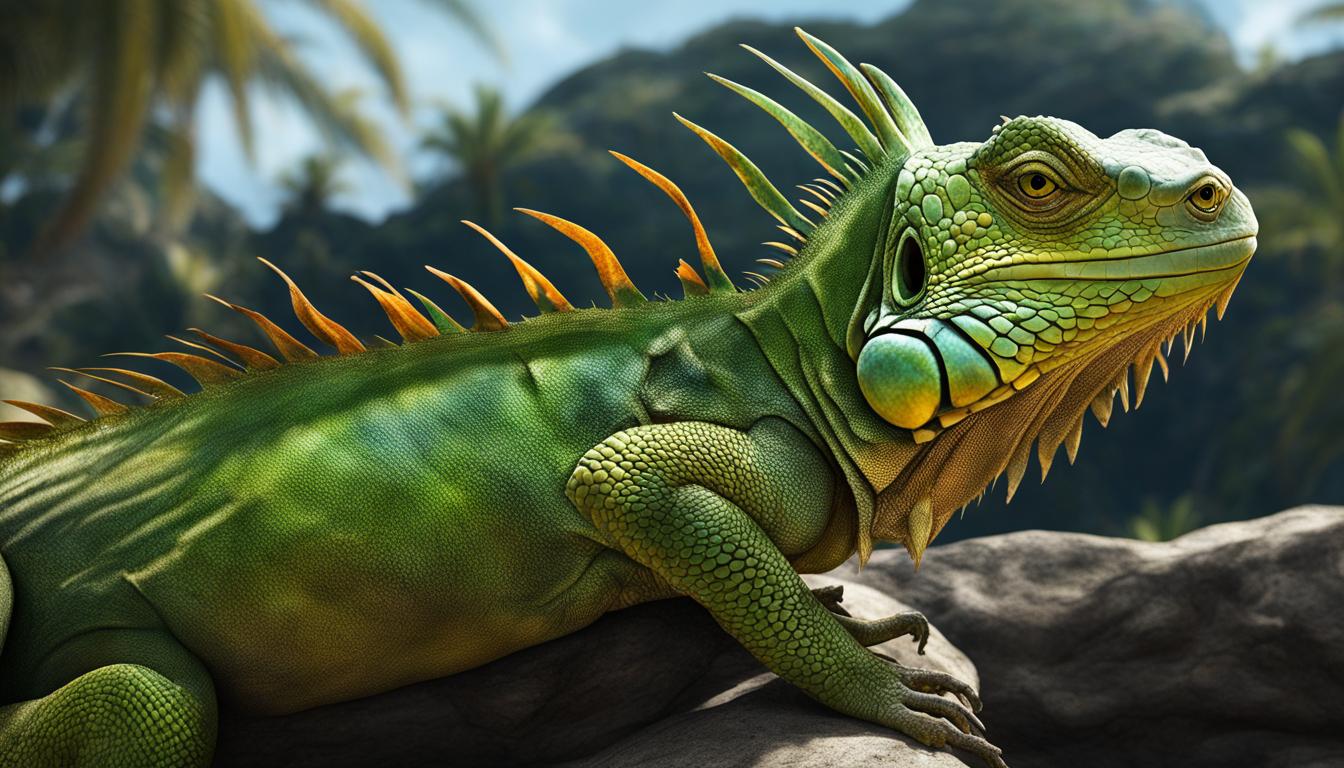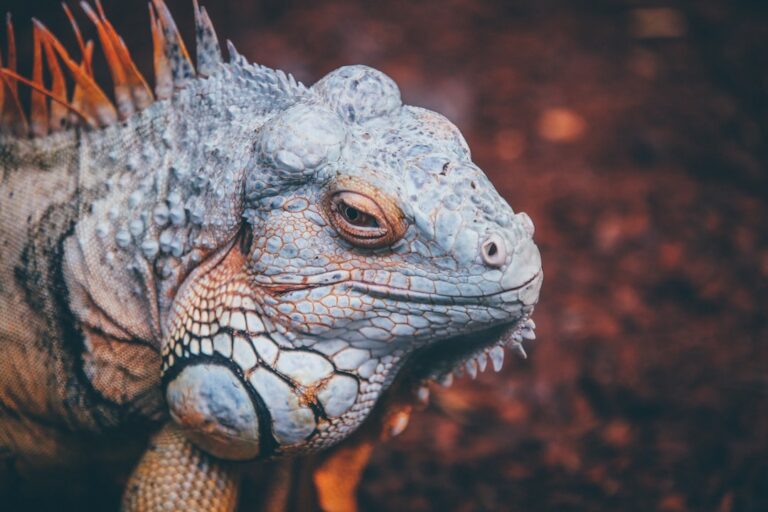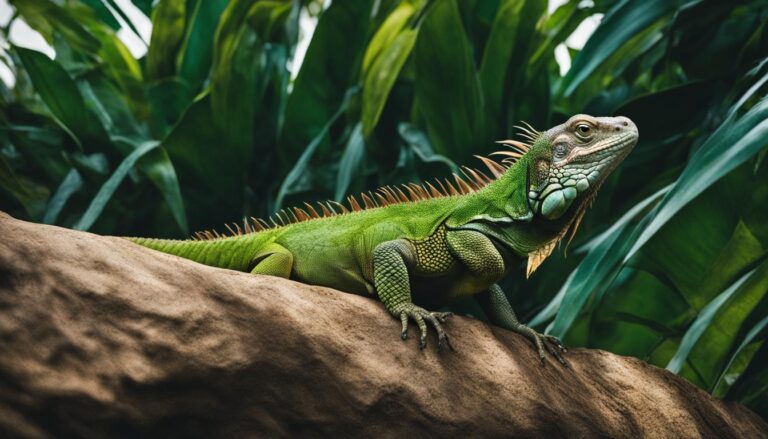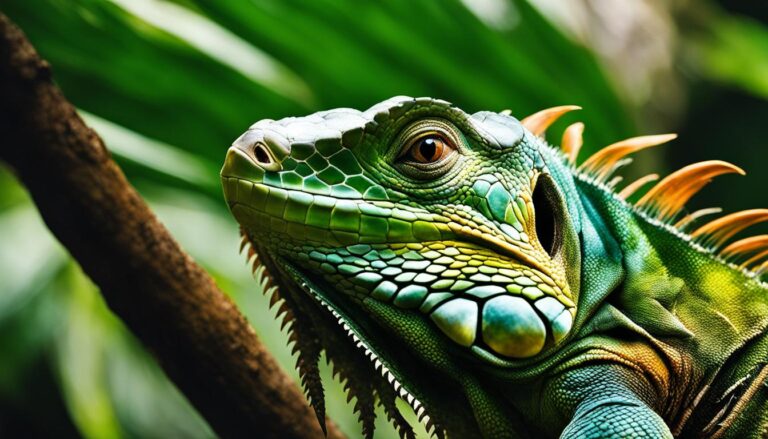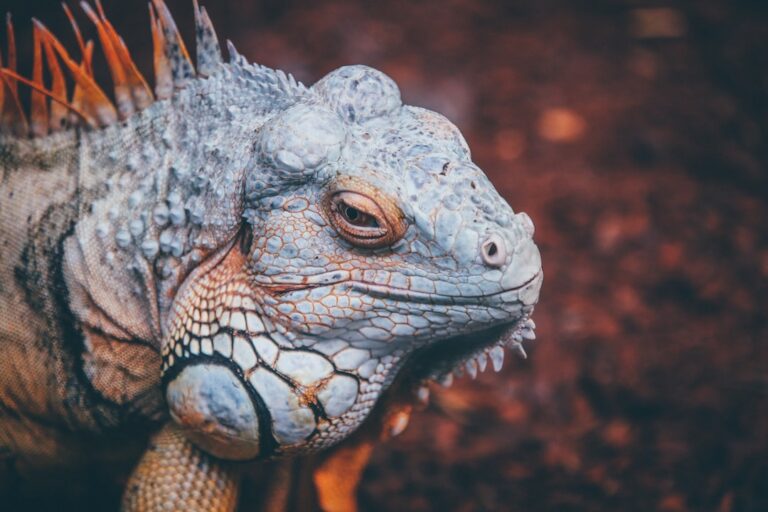Do Iguanas Have Mammary Glands?
Welcome to our informative article on the fascinating world of iguanas! Have you ever wondered if iguanas have mammary glands like mammals do? In this article, we will explore the biology of iguanas and delve into the truth behind their milk production. Let’s uncover the facts about these incredible reptiles and their unique reproductive processes.
As reptiles, iguanas do not possess mammary glands, which means they cannot produce milk to feed their young. Unlike mammals, who give birth to live young, iguanas lay eggs. Hatchlings emerge from these eggs after a few months of incubation. Although iguanas do produce a white liquid in their feces, this is not actual milk but a substance called urate.
It’s important for iguana owners to be aware of this distinction and to monitor their pet’s health, especially during breeding seasons. Semen may mix with the white liquid in their feces, causing it to resemble milk. Regular fecal checks are crucial for ensuring the well-being of these beloved pets.
Table of Contents
Key Takeaways:
- Iguanas are reptiles and do not have mammary glands like mammals.
- They lay eggs and their young hatch after a few months of incubation.
- The white liquid seen in their feces is called urate, not milk.
- During breeding seasons, semen may mix with the urate, giving it a more milky appearance.
- Regular fecal checks are necessary to monitor the health of pet iguanas.
Iguana Anatomy and Physiology
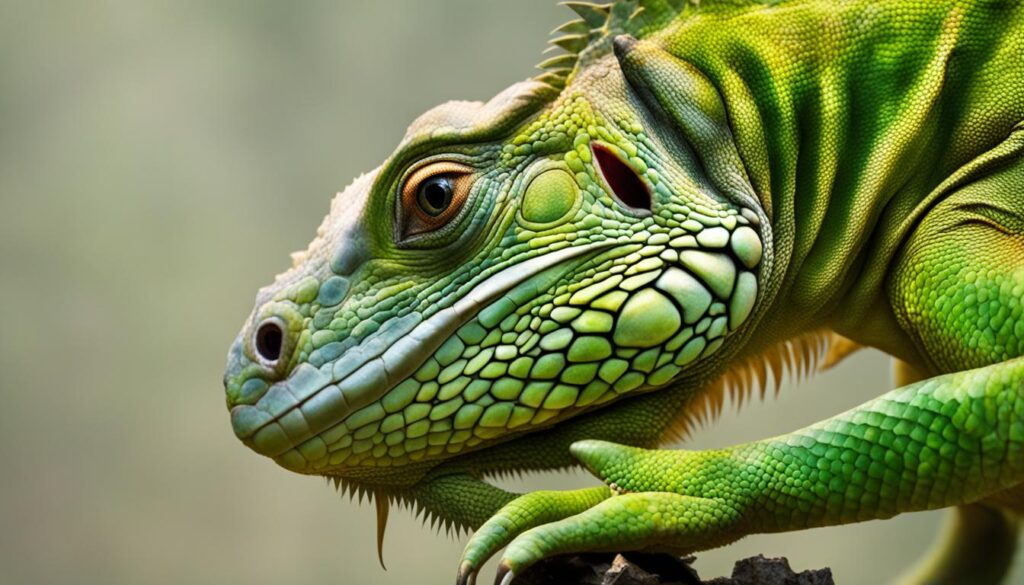
Iguanas are fascinating reptiles with unique anatomy and physiology. Let’s explore some of the key characteristics that make them distinct from mammals and other reptiles.
Scales and Skin
One of the most noticeable features of iguanas is their scaly skin. These scales serve as a protective barrier, providing defense against predators and helping to regulate body temperature. Unlike mammals, which have fur or feathers, iguanas rely on their scales to maintain their physical integrity and adapt to their environment.
Egg-Laying Reproduction
Similar to other reptiles, iguanas reproduce by laying eggs. Female iguanas will find a suitable nesting site, typically in sandy soil, where they will lay their eggs. The eggs are then incubated for several months until they hatch, at which point the young iguanas emerge from the nest. This method of reproduction is vastly different from mammals, which give birth to live young.
Absence of Mammary Glands
Unlike mammals, iguanas do not possess mammary glands. These glands are responsible for milk production in mammals, allowing them to nourish their offspring during the early stages of life. Instead, iguanas rely on their yolk sac and the nutrients obtained from their diet to support their development after hatching.
| Characteristics | Iguanas | Mammals | Other Reptiles |
|---|---|---|---|
| Body Covering | Scales | Fur or Feathers | Scaly Skin |
| Method of Reproduction | Egg-Laying | Live Birth | Egg-Laying |
| Mammary Glands | Absent | Present | Absent |
Despite their differences from mammals, iguanas have evolved unique adaptations that allow them to thrive in their environments. Their scales provide protection and aid in thermoregulation, while their egg-laying reproductive strategy ensures the survival of their species. While they may not have mammary glands, iguanas have developed alternative mechanisms to nourish their young after hatching.
Understanding the anatomy and physiology of iguanas is crucial for pet owners and anyone interested in these reptiles. By appreciating their unique characteristics, we can ensure proper care and conservation of these fascinating creatures.
Misconceptions about Iguana Milk Production
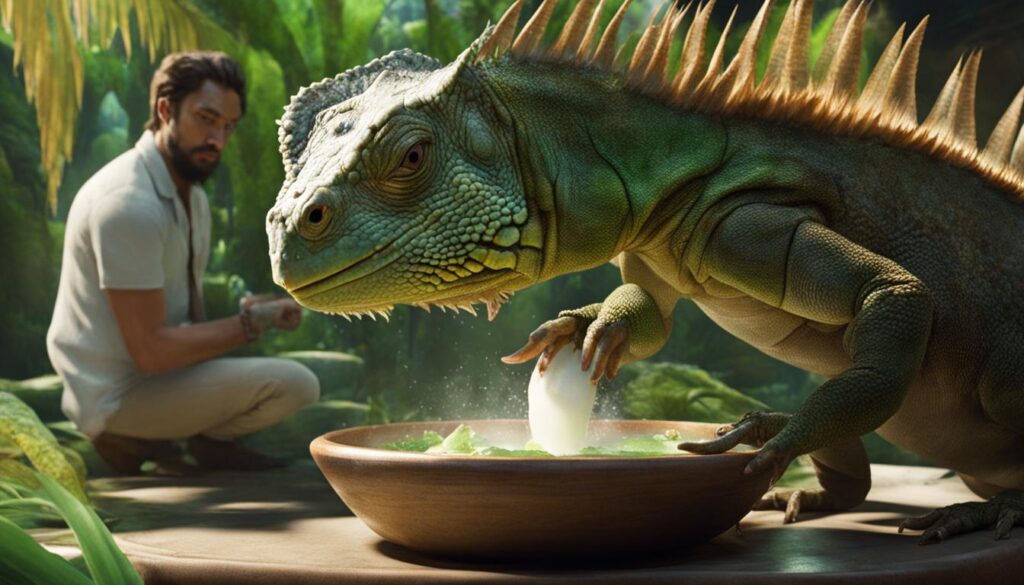
There is a common misconception that iguanas produce milk. However, the white liquid that is sometimes seen in their feces is not milk. It is a substance called urate, which is produced by the kidneys and mixed with fecal matter. During the breeding season, semen may also be present in the feces, giving it a more milky appearance. It is important for iguana owners to be aware of these misconceptions and understand the true nature of the substance found in their pet’s feces.
While it may be easy to mistake the white liquid in iguana feces for milk, it is crucial to remember that reptiles like iguanas do not have mammary glands and, therefore, cannot produce milk. The presence of urate in their feces is a natural occurrence and should not be cause for concern. However, it is essential for iguana owners to monitor their pets’ health during the breeding season, as the presence of semen in the feces can indicate potential health problems. Regular veterinary check-ups and fecal examinations can help ensure the well-being of iguanas and address any health issues.
In summary, iguanas do not produce milk, and the white liquid in their feces is not milk but rather a substance called urate. Understanding this misconception is crucial for responsible iguana ownership and proper care of these reptiles. By debunking myths and misconceptions, iguana owners can provide the best possible care for their pets and ensure their health and well-being.
Table: Milk vs. Urate Comparison
| Milk | Urate | |
|---|---|---|
| Composition | Contains lactose, proteins, and fats | Does not contain lactose, proteins, or fats |
| Production | Produced by mammary glands in mammals | Produced by the kidneys in reptiles |
| Function | Provides nutrition and antibodies to offspring | Excretory waste product |
| Appearance | Opaque, creamy color | White, chalky appearance |
| Presence during breeding season | Not applicable to iguanas | Semen may be mixed with urate, giving it a milky appearance |
Mammalian Mammary Glands and Milk Production
Mammalian mammary glands are unique structures found in female mammals that are responsible for milk production and lactation. This remarkable adaptation allows female mammals to provide essential nutrition and care for their offspring. Milk production is regulated by a complex interplay of hormones and is a key aspect of the mother-offspring bond in mammals.
The mammary glands undergo significant changes during pregnancy and lactation. In response to hormonal signals, the glands develop and produce milk, which is rich in proteins, fats, sugars, and antibodies. The composition of mammalian milk is tailored to meet the specific nutritional needs of the young, ensuring their growth and development.
The process of lactation involves the release of milk through the nipples, allowing the offspring to suckle and receive nourishment. Hormones such as prolactin and oxytocin play crucial roles in milk production and the let-down reflex, which triggers the release of milk from the mammary glands. This intricate hormonal regulation ensures that the offspring receive a consistent supply of milk throughout the nursing period.
| Mammalian Mammary Glands | Milk Production | Lactation |
|---|---|---|
| Mammary glands are specialized structures found in female mammals. | Milk production is regulated by hormones and results in the secretion of milk from the mammary glands. | Lactation is the process of providing milk to offspring through nursing. |
| Mammary glands develop during pregnancy and produce milk to nourish the young. | Milk is rich in proteins, fats, sugars, and antibodies, providing essential nutrition for the young. | The let-down reflex, triggered by hormones, releases milk from the mammary glands for suckling. |
| The mother-offspring bond is strengthened through nursing and the provision of maternal care. | Milk production is a unique characteristic of mammals and contributes to species survival and development. | Lactation ensures the growth, health, and well-being of mammalian offspring. |
Other Animals That Produce Milk
While mammals are the primary group of animals that produce milk, there are some intriguing exceptions in the animal kingdom. Let’s explore a few examples of non-mammal milk production:
Birds
Some birds have evolved the ability to produce a milk-like substance called “crop milk” to feed their young. This specialized secretion is produced in the crop, a modified part of the esophagus. Pigeons, for example, regurgitate crop milk to provide vital nutrients to their chicks.
Amphibians and Fish
While not as commonly known, certain species of amphibians and fish also exhibit milk-like substances. These fluids contain essential nutrients and are used to nourish their offspring. Some amphibians, such as poison dart frogs, produce a nutritious secretion to feed their tadpoles, while certain species of fish, like the discus fish, produce a skin secretion often referred to as “milk.”
Insects and Bats
Believe it or not, even some insects can produce milk-like substances. For instance, certain species of cockroaches provide a liquid secretion to their developing embryos, which serves as a source of nutrition. Additionally, male bats, specifically fruit bats, have been found to have mammary glands and produce milk to nourish their young.
Table: Animals That Produce Non-Mammal Milk
| Animal | Method of Milk Production |
|---|---|
| Birds | Crop milk produced in crop |
| Amphibians | Nutritious secretion for offspring |
| Fish | Specialized skin secretion |
| Insects | Liquid secretion for embryos |
| Bats | Male fruit bats lactate and produce milk |
While mammalian milk production is the most well-known, these examples demonstrate the remarkable adaptations found in nature. From birds and amphibians to fish and insects, non-mammal milk plays a crucial role in the survival and development of various species.
The Importance of Mammary Glands in Mammals
The evolution of mammary glands and the production of mammalian milk have played a vital role in the survival and success of mammalian species. Mammary glands are unique to mammals and serve as a source of nutrition for their offspring. Milk produced by these glands contains essential nutrients and antibodies that support the growth and development of mammalian young.
The function of mammary glands goes beyond providing sustenance. Milk also plays a crucial role in establishing the bond between mother and offspring. It is during the nursing period that mammals develop a strong emotional connection, fostering a sense of security and well-being. This bond enhances the chances of survival for the newborns, as maternal care and nourishment are critical during this vulnerable stage of life.
The importance of mammary glands can be attributed to mammalian evolution. The development of these glands allowed mammals to adapt to various environments and food sources. The ability to produce and provide milk to their young increased the chances of species survival and diversification. The evolution of mammary glands and the ability to produce milk are remarkable adaptations that have contributed to the success and longevity of mammals.
In summary, mammary glands are a defining feature of mammals and play a multifaceted role in their survival. The production of mammalian milk not only serves as a source of nutrition but also establishes a strong mother-offspring bond. Mammary glands have evolved over time, enabling mammals to adapt to different environments and contribute to the continued existence of various mammalian species.
Reptilian Reproduction and Offspring Care
Reptiles have a unique reproductive strategy compared to mammals. Instead of giving live birth, reptiles lay eggs as a means of reproduction. Once the eggs are laid, reptile parents do not provide direct care for their offspring. Unlike mammals, which nurse their young with milk produced by mammary glands, reptilian offspring must fend for themselves after hatching. This fundamental difference in parenting behavior is a result of the divergent evolutionary paths of reptiles and mammals.
Reptile eggs are typically deposited in a safe location where they can develop undisturbed. The incubation period varies depending on the species, but it generally takes several weeks to several months for the eggs to hatch. During this time, the embryos develop and absorb the necessary nutrients from the yolk sac within the egg. Once the eggs hatch, the hatchlings emerge fully formed and ready to navigate the world on their own.
This reproductive strategy has allowed reptiles to adapt and thrive in various environments. By producing a large number of offspring, reptiles increase their chances of survival, as some individuals are bound to survive and carry on the species. This is in contrast to mammals, which invest more energy and resources into producing a smaller number of offspring with a higher chance of survival through parental care and milk production.
Table: Comparison of Reproductive Strategies in Reptiles and Mammals
| Aspect | Reptiles | Mammals |
|---|---|---|
| Offspring Care | Minimal or no parental care | Extensive parental care |
| Reproduction | Egg laying | Live birth |
| Offspring Independence | Hatchlings are self-sufficient | Offspring require care and nourishment from parents |
| Number of Offspring | High, with a lower chance of survival for each individual | Low, with a higher chance of survival for each individual |
Understanding the differences in reproductive strategies between reptiles and mammals provides insights into the diverse ways that animals have evolved to ensure the survival of their species. While reptiles may not exhibit the same level of parental care and milk production as mammals, their unique reproductive strategy has proven successful for millions of years.
Iguana Adaptations for Survival
Iguanas have evolved several adaptations that enable them to thrive in their natural habitats. These adaptations contribute to their ability to regulate body temperature, obtain water and hydration, and navigate their environment. Understanding these unique characteristics is essential for providing proper care to pet iguanas.
Thermoregulation
One of the key adaptations of iguanas is their ability to regulate their body temperature. As ectothermic reptiles, iguanas rely on external heat sources to warm their bodies. They bask in the sun to absorb heat and increase their body temperature. Conversely, they seek shade or cooler areas to lower their body temperature. This thermoregulation behavior allows iguanas to maintain their optimal body temperature for various physiological functions.
Water and Hydration
Iguanas obtain most of their hydration from the vegetation they consume. They have a well-developed digestive system that efficiently extracts water from their food. However, they still require access to clean drinking water to supplement their hydration needs. Pet iguanas should have a shallow water dish available at all times to ensure proper hydration.
Sensory Capabilities
Iguanas have unique sensory adaptations that aid in their survival. They have a parietal eye, also known as a third eye, on top of their head. While not capable of forming detailed images, this eye is sensitive to changes in light and helps detect potential predators. Additionally, iguanas have excellent visual and olfactory senses, allowing them to navigate their environment and locate food sources.
Iguana Behavior and Diet
Iguanas exhibit specific behaviors and dietary preferences that contribute to their adaptation for survival. They are primarily herbivorous, consuming a variety of fruits, vegetables, and leafy greens. Their specialized teeth and digestive system are well-suited for processing plant material. Additionally, iguanas are known for their ability to camouflage and blend into their surroundings, providing them with protection against predators.
| Adaptations | Description |
|---|---|
| Thermoregulation | Iguanas regulate their body temperature by basking in the sun or seeking shade. |
| Water and Hydration | Iguanas obtain most of their hydration from the vegetation they consume but still require access to clean drinking water. |
| Sensory Capabilities | Iguanas have a parietal eye, excellent visual and olfactory senses, and the ability to detect potential predators. |
| Behavior and Diet | Iguanas exhibit specific herbivorous behaviors and dietary preferences and are known for their ability to camouflage. |
Overall, the adaptations of iguanas allow them to thrive in their natural environments. When caring for a pet iguana, it is important to provide an environment that allows for thermoregulation, access to fresh water, and a diet that mimics their natural herbivorous preferences. By understanding and meeting these needs, iguana owners can ensure the well-being and happiness of their scaly companions.
Iguana Health and Care Tips
Proper care and monitoring of an iguana’s health are essential for their well-being. Regular veterinary check-ups, including fecal checks, can help identify any health issues early on. It is important to find a veterinarian experienced in reptile care to ensure your iguana receives the best possible care. A qualified veterinarian will be able to provide guidance on proper diet, environmental conditions, and any specific health concerns that may arise.
When it comes to diet, iguanas are herbivores and require a varied and balanced diet. Their diet should consist of leafy greens, vegetables, fruits, and occasional protein sources such as insects. It is crucial to provide high-quality, fresh food and ensure that the diet is rich in calcium and vitamin D3 to support healthy bone growth and prevent metabolic bone disease.
Hydration is another vital aspect of iguana care. Iguanas obtain most of their hydration from the plants they eat, but it is essential to provide clean, fresh water for drinking and bathing. A shallow dish of water should be available at all times, and the water should be changed regularly to prevent bacterial growth.
| Health Tips for Iguana Care | Guidelines |
|---|---|
| Veterinary Care | Regular check-ups and fecal checks with a reptile-experienced veterinarian. |
| Diet | Offer a balanced diet of leafy greens, vegetables, fruits, and occasional protein sources. |
| Hydration | Provide fresh water for drinking and regular bathing. |
| Environmental Needs | Create a suitable habitat with proper temperature, humidity, and space. |
In addition to veterinary care, diet, and hydration, creating a suitable habitat is crucial for an iguana’s well-being. Iguanas require a spacious enclosure with proper temperature and humidity levels. The habitat should include areas for basking, hiding, and climbing to replicate their natural environment. It is important to provide a UVB light source to ensure proper calcium metabolism and prevent metabolic bone disease.
Iguanas are sensitive to changes in their environment, so it is essential to maintain a stable and stress-free environment for them. Avoid sudden temperature fluctuations, excessive handling, and overcrowded living conditions. Regular cleaning and maintenance of the enclosure are necessary to prevent the buildup of bacteria and parasites.
By following these health and care tips, iguana owners can ensure the well-being and longevity of their pets. Responsible iguana ownership requires a commitment to providing proper veterinary care, a balanced diet, adequate hydration, and a suitable habitat. With the right care and attention, iguanas can thrive and bring joy to their owners for many years.
Conclusion
In summary, it is important to understand the biology of iguanas and the absence of mammary glands in these fascinating reptiles. Unlike mammals, iguanas do not have the ability to produce milk to nourish their young. Instead, they reproduce by laying eggs, which hatch after a few months. The white liquid that is sometimes seen in their feces can be mistaken for milk, but it is a substance called urate and not actual milk.
Responsible pet ownership of iguanas requires owners to be aware of these facts and to seek regular veterinary check-ups, especially during breeding seasons when semen may be mixed with the white liquid in their feces. Providing a suitable environment that meets their temperature, humidity, and space needs, as well as a balanced and nutritious diet, is crucial for the health and well-being of iguanas. Access to clean water for hydration and bathing is also essential.
By understanding the unique biology of iguanas and their lack of mammary glands, we can ensure that these remarkable reptiles receive the care and attention they need to thrive as pets.
FAQ
Do iguanas have mammary glands?
No, iguanas do not have mammary glands. They are reptiles and do not produce milk.
What is the white liquid in iguana feces?
The white liquid in iguana feces is called urate. It is not milk.
Can the white liquid in iguana feces be mistaken for milk?
Yes, the white liquid in iguana feces can sometimes be mistaken for milk, but it is not milk. It is important to understand this misconception.
How can I distinguish between milk and the white liquid in iguana feces?
Milk is not produced by iguanas. The white liquid in their feces is urate, which is produced by the kidneys and mixed with fecal matter.
What should iguana owners be aware of during breeding seasons?
During breeding seasons, semen may be mixed with the white liquid in iguana feces, giving it a more milky appearance.
Do reptiles have mammary glands?
No, mammary glands are not present in reptiles. They are a unique characteristic of mammals.
How do iguanas reproduce?
Iguanas reproduce by laying eggs. They do not give birth to live young.
Do iguanas provide parental care for their offspring?
No, once iguana eggs are laid, the parents do not provide direct care for their offspring. The hatchlings must fend for themselves.
What are some adaptations that help iguanas survive?
Iguanas have adaptations such as thermoregulation, obtaining hydration from the plants they eat, and unique sensory capabilities.
How can I properly care for an iguana?
Proper care for an iguana includes regular veterinary check-ups, a balanced and nutritious diet, and providing a suitable environment that meets their needs for temperature, humidity, and space.

